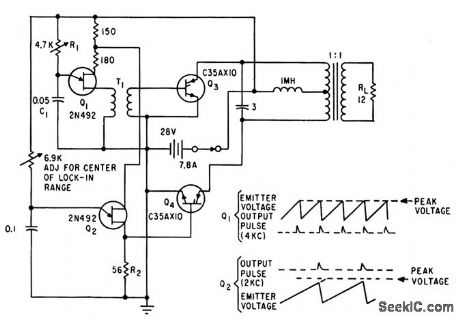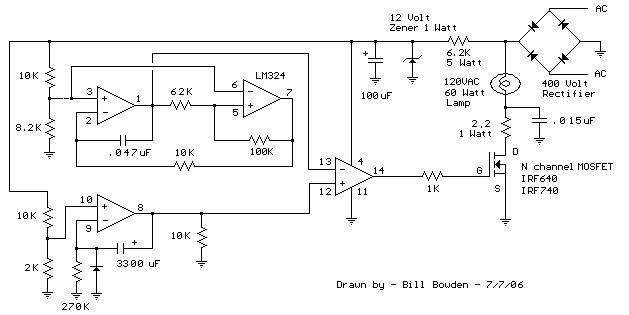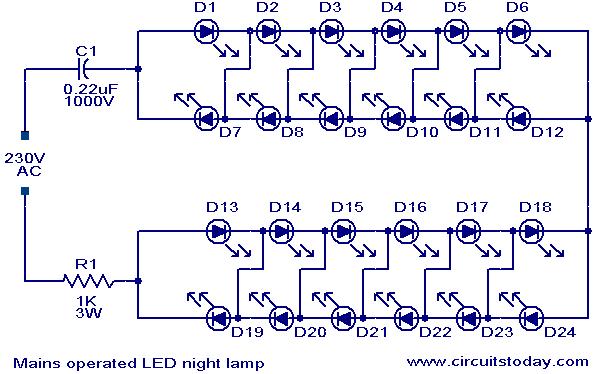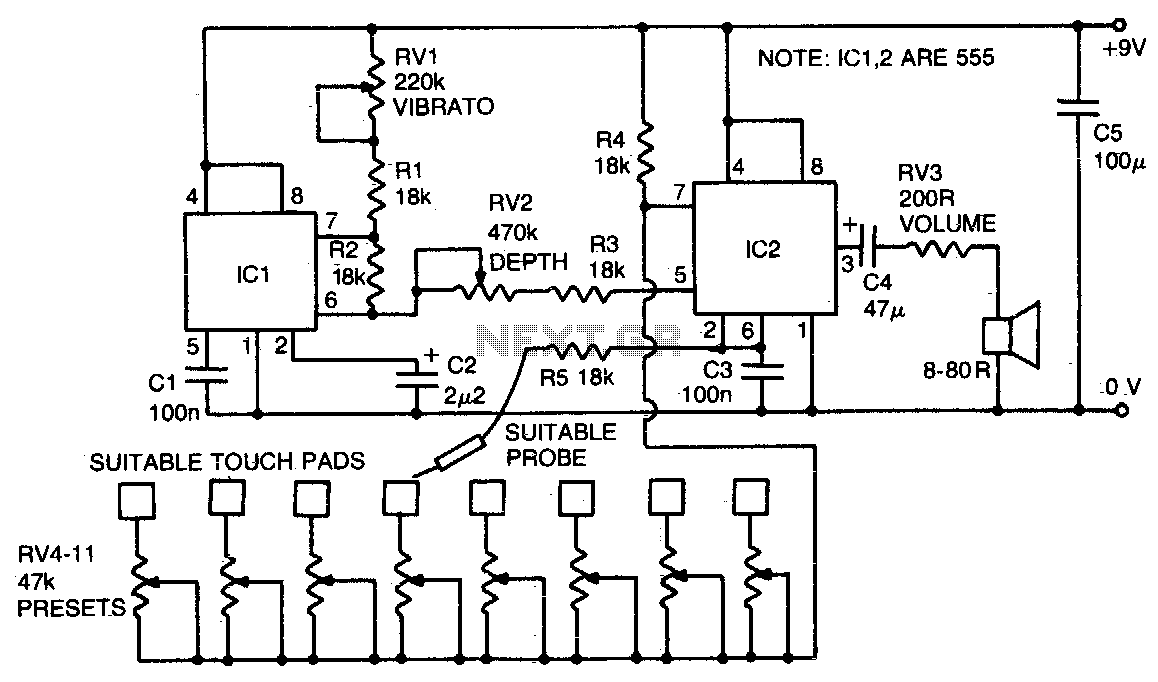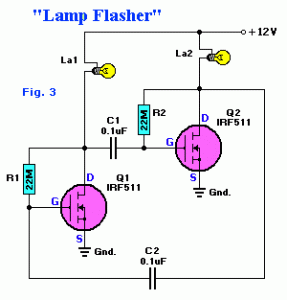
4 channels Lamp organ
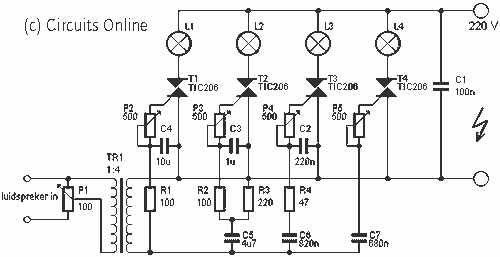
This light organ is on the speaker output of the amplifier. The lamps lit on the rhythm of the music. The input signal is amplified by a transformer. Then it goes through a monolingual filters comprising resistors and capacitors to the pots and then to the triacs. By the filters respond to each triac a separate frequency, T1 is the bass and T4 for the high. P2 to P5, the sensitivity for each set triac. P1 controls the sensitivity of the whole circuit. More: Parts List R1, R2 = 100 Ω / 0.5 W R3 = 220 Ω / 0.5 W R4 = 47 Ω / 0.5 W P1 = 100 Ω P2-P5 = 500 Ω C1 = 100 V nF/500 C2 = 220 nF The transformer itself should probably be wrapped. This may in 100 primary and 400 secondary windings of copper wire with a diameter of 0.1 to 0.3 mm. Note the fact that the whole circuit power flows. Therefore, only use plastic pots with ash and mica plates as you want cool triacs. C3 = 1 µF C4 = 10 µF C5 = 4.7 µF C6 = 820 nF C7 = 680 nF T1-T4 = TIC 206 L1-L4 = 600 W max lamp TR1 = 1:4 transformer
The described light organ circuit operates by responding to audio signals from an amplifier, allowing lamps to illuminate in sync with the rhythm of the music. The core functionality begins with the audio input being amplified using a transformer (TR1) with a turns ratio of 1:4, which increases the voltage level of the audio signal for further processing.
Following amplification, the signal is filtered through a series of monophonic filters composed of resistors (R1-R4) and capacitors (C1-C7). These filters separate the audio signal into distinct frequency bands, enabling the circuit to control different lamps (L1-L4) based on the frequency content of the music. The triacs (T1-T4), specifically TIC 206 types, are employed to switch the lamps on and off in response to the filtered audio signals. Each triac corresponds to a specific frequency range: T1 is dedicated to bass frequencies, while T4 is tuned for higher frequencies.
Potentiometers (P1-P5) are integrated into the circuit to adjust the sensitivity of the triacs and the overall circuit. P1 manages the general sensitivity, while P2 to P5 fine-tune the sensitivity for each individual triac, allowing for a customizable response to the audio input.
The components are carefully selected to handle the power requirements of the circuit. Resistors are rated at 0.5 W, with values of 100 Ω for R1 and R2, 220 Ω for R3, and 47 Ω for R4. Capacitors are used to filter and stabilize the signals, with values ranging from 680 nF to 10 µF. The transformer is specified to have 100 primary turns and 400 secondary turns, constructed from copper wire with a diameter between 0.1 mm and 0.3 mm, ensuring efficient signal handling.
It is crucial to utilize plastic potentiometers with ash and mica plates in this circuit to maintain thermal management, as the triacs can generate significant heat during operation. The maximum lamp load for each triac is rated at 600 W, ensuring that the circuit can handle substantial lighting demands while operating safely within its designed parameters.This light organ is on the speaker output of the amplifier. The lamps lit on the rhythm of the music. The input signal is amplified by a transformer. Then it goes through a monolingual filters comprising resistors and capacitors to the pots and then to the triacs. By the filters respond to each triac a separate frequency, T1 is the bass and T4 for the high. P2 to P5, the sensitivity for each set triac. P1 controls the sensitivity of the whole circuit. Parts List R1, R2 = 100 ? / 0.5 W R3 = 220 ? / 0.5 W R4 = 47 ? / 0.5 W P1 = 100 ? P2-P5 = 500 ? C1 = 100 V nF/500 C2 = 220 nF The transformer itself should probably be wrapped. This may in 100 primary and 400 secondary windings of copper wire with a diameter of 0.1 to 0.3 mm. Note the fact that the whole circuit power flows. Therefore, only use plastic pots with ash and mica plates as you want cool triacs. C3 = 1 uF C4 = 10 uF C5 = 4.7 uF C6 = 820 nF C7 = 680 nF T1-T4 = TIC 206 L1-L4 = 600 W max lamp TR1 = 1:4 transformer 🔗 External reference
The described light organ circuit operates by responding to audio signals from an amplifier, allowing lamps to illuminate in sync with the rhythm of the music. The core functionality begins with the audio input being amplified using a transformer (TR1) with a turns ratio of 1:4, which increases the voltage level of the audio signal for further processing.
Following amplification, the signal is filtered through a series of monophonic filters composed of resistors (R1-R4) and capacitors (C1-C7). These filters separate the audio signal into distinct frequency bands, enabling the circuit to control different lamps (L1-L4) based on the frequency content of the music. The triacs (T1-T4), specifically TIC 206 types, are employed to switch the lamps on and off in response to the filtered audio signals. Each triac corresponds to a specific frequency range: T1 is dedicated to bass frequencies, while T4 is tuned for higher frequencies.
Potentiometers (P1-P5) are integrated into the circuit to adjust the sensitivity of the triacs and the overall circuit. P1 manages the general sensitivity, while P2 to P5 fine-tune the sensitivity for each individual triac, allowing for a customizable response to the audio input.
The components are carefully selected to handle the power requirements of the circuit. Resistors are rated at 0.5 W, with values of 100 Ω for R1 and R2, 220 Ω for R3, and 47 Ω for R4. Capacitors are used to filter and stabilize the signals, with values ranging from 680 nF to 10 µF. The transformer is specified to have 100 primary turns and 400 secondary turns, constructed from copper wire with a diameter between 0.1 mm and 0.3 mm, ensuring efficient signal handling.
It is crucial to utilize plastic potentiometers with ash and mica plates in this circuit to maintain thermal management, as the triacs can generate significant heat during operation. The maximum lamp load for each triac is rated at 600 W, ensuring that the circuit can handle substantial lighting demands while operating safely within its designed parameters.This light organ is on the speaker output of the amplifier. The lamps lit on the rhythm of the music. The input signal is amplified by a transformer. Then it goes through a monolingual filters comprising resistors and capacitors to the pots and then to the triacs. By the filters respond to each triac a separate frequency, T1 is the bass and T4 for the high. P2 to P5, the sensitivity for each set triac. P1 controls the sensitivity of the whole circuit. Parts List R1, R2 = 100 ? / 0.5 W R3 = 220 ? / 0.5 W R4 = 47 ? / 0.5 W P1 = 100 ? P2-P5 = 500 ? C1 = 100 V nF/500 C2 = 220 nF The transformer itself should probably be wrapped. This may in 100 primary and 400 secondary windings of copper wire with a diameter of 0.1 to 0.3 mm. Note the fact that the whole circuit power flows. Therefore, only use plastic pots with ash and mica plates as you want cool triacs. C3 = 1 uF C4 = 10 uF C5 = 4.7 uF C6 = 820 nF C7 = 680 nF T1-T4 = TIC 206 L1-L4 = 600 W max lamp TR1 = 1:4 transformer 🔗 External reference

